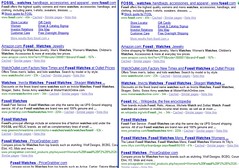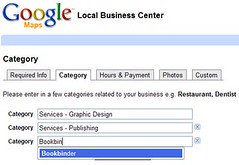New Ranking Methodology for Google Image Search
The New York Times is reporting on a new research paper about Google’s new image ranking algo which apparently associates an inferred linking relationship between images and uses the PageRank method of iterating ranking values across the graph to come up with final ranking values. This “VisualRank” method was presented in a paper at the International World Wide Web Conference in Beijing this past Thursday, and the process was also reported at Techcrunch.

Google’s advancements in Image Search
could help keep high-value image results
like this coastal pic stay high in the SERPs
for apropos keywords, while making less-
important images rank far lower.
The new methodology is apparently very adept at weeding out less-important and less-useful images from the search results.
I have earlier reported on Google’s research into Supervised Multiclass Labeling (“SML”) which can assist with associating keywords with the actual content found within digital images. See also Search Engine Land’s article on Google’s VisualRank Paper.
Possible Related Posts
Posted by Chris of Silvery on 04/28/2008
Permalink | |  Print
| Trackback | Comments Off on New Ranking Methodology for Google Image Search | Comments RSS
Print
| Trackback | Comments Off on New Ranking Methodology for Google Image Search | Comments RSS
Filed under: Google, Image Optimization Google, image-search, Image-Search-Optimization, VisualRank
Digital Graffiti Goes Mainstream: TIME Magazine Article
I noticed that TIME covered the laser graffiti artists of the Graffiti Research Lab this week. Nearly a year ago, I covered the phenomenon of guerrilla marketing via laser light images “drawn” on the sides of buildings at night.
Having this covered in a mainstream rag like TIME is probably nearly enough to make the concept jump the shark, and the novelty element and guerrilla marketing value could be virtually annihilated by familiarity.
I’m not really complaining so much as noting the effect — and noting that the promotion value of the medium could become rapidly eroded when it’s too common. The novelty and amusement factor could give way to annoyance if laser displayed images on buildings became frequent. When a methodology hits mainstream, it’s no longer “guerrilla”. 🙂
Possible Related Posts
Posted by Chris of Silvery on 04/15/2008
Permalink | |  Print
| Trackback | Comments Off on Digital Graffiti Goes Mainstream: TIME Magazine Article | Comments RSS
Print
| Trackback | Comments Off on Digital Graffiti Goes Mainstream: TIME Magazine Article | Comments RSS
Filed under: Futurism, Marketing, News graffiti, guerrilla advertising, guerrilla marketing
Travel Searches, Local & More Searches Turning Case-Sensitive in Google SERPs
Some of us at Netconcepts have been noticing that keyword rankings in Google search engine results pages (“SERPs”) have been turning case-sensitive for some queries lately. Search Engine Roundtable highlighted that the case sensitivity issue had been reported for queries seen in the UK, but we’ve been seeing it for queries committed from the US as well.
For instance, search for something like “fossil watches” and compare with “Fossil Watches”, and you’ll see that a few of the listings in the SERPs trade ranking positions:
Possible Related Posts
Posted by Chris of Silvery on 04/15/2008
Permalink | |  Print
| Trackback | Comments Off on Travel Searches, Local & More Searches Turning Case-Sensitive in Google SERPs | Comments RSS
Print
| Trackback | Comments Off on Travel Searches, Local & More Searches Turning Case-Sensitive in Google SERPs | Comments RSS
Filed under: Google, Local Search, Local Search Optimization, Search Engine Optimization, Searching, SEO case sensitive, case sensitivity, Google, Keyword-Rankings, search engine results pages, SEO, SERPs
Google Maps Now Allows Custom Categories For Businesses
Search Engine Roundtable notes that the Google Local Business Center is allowing businesses to enter their own, custom categories. While this new functionality has been around for a few weeks now, it is an important one and addresses a major need that both Mike Blumenthal and I have highlighted previously — I recently spoke about this issue again at the SMX West session on Local Search & Blended Results. Previously, businesses could only select business categories from an unusually short list of categories. Exacerbating the issue, some businesses achieved other category associations outside of Google’s sharply limited taxonomy when their listings found in other yellow pages providers such as Superpages were absorbed into Google Maps, including the more comprehensive categories found in those other content sources.
Under the new functionality, businesses may type in custom business categories, and the interface also provides helpful potential term using the Google Suggestion Tool:
Free-form categories is a slightly unique way to address the need of businesses. Yellow pages companies have traditionally offered businesses the option of categorization under many thousands of unique categories — on the order of twelve thousand to fifteen thousand categories in some cases. However, YP companies have also carefully considered and turned down requests for additions of completely new categories in some cases, mainly due to how yellow pages are constructed — if there are too few businesses in a category it won’t make monetary sense to add it into a directory. And, if the category name is too esoteric, consumers won’t search for it anyway.
With Google’s local search operating more closely as a straight keyword search tool, businesses could associate categories with themselves that are as specific as they desire without affecting usability or cost.
In other, related news, Google has announced that YouTube videos are now integrated with Google Maps, allowing businesses to add video info to their listings.
Possible Related Posts
Posted by Chris of Silvery on 04/15/2008
Permalink | |  Print
| Trackback | Comments Off on Google Maps Now Allows Custom Categories For Businesses | Comments RSS
Print
| Trackback | Comments Off on Google Maps Now Allows Custom Categories For Businesses | Comments RSS
Filed under: Google, Local Search, Maps, Online Directories, Searching, Yellow Pages
Where’s Waldo in Google Earth
In a very clever bit of marketing, Canadian artist Melanie Coles has created a large rooftop image of the iconic character found in the popular Where’s Waldo? book series.
The image is located somewhere in Vancouver, British Columbia, and was created with the specific intention of being findable via Google Earth (warning, I have the location pinpointed in a link and geocoordinates at the end of this post). It will be a while before Waldo can be found in Google Earth (or in Google Maps, Yahoo! Maps, or MS Live Search Maps, for that matter), because there is a time lag in between when satellite images and aerial photos get updated in those services — so, it could be six months to a year before the image is really findable and viewable online.
The image was created as a demonstration of a viral game for Coles’ graduation art project at the Emily Carr Institute. Her blog statement on the project says: (more…)
Possible Related Posts
Posted by Chris of Silvery on 04/14/2008
Permalink | |  Print
| Trackback | Comments Off on Where’s Waldo in Google Earth | Comments RSS
Print
| Trackback | Comments Off on Where’s Waldo in Google Earth | Comments RSS
Filed under: Google, Maps, News aerial-photos, Google-Earth, Google-Maps, Maps, Mapvertising, Roofvertising, Satellite-Images, Viral-Marketing, Where's Waldo
Google’s KML Becomes Industry Standard
 In an example of how becoming top dog can empower a company to influence and set industry-wide protocols, Google Earth’s KML format has been declared an open standard for geographical data by the Open Geospatial Consortium (“OGC”).
In an example of how becoming top dog can empower a company to influence and set industry-wide protocols, Google Earth’s KML format has been declared an open standard for geographical data by the Open Geospatial Consortium (“OGC”).
It’s really great and progressive that such a large, publicly-traded company such as Google would release control of its considerable intellectual property rights and allow KML to be used by anyone.
Google’s LatLong Blog also crows a bit about how KML is “the HTML of geographic content”, and explains that KML is no longer owned by Google, but is now administrated by the OGC.
Possible Related Posts
Posted by Chris of Silvery on 04/14/2008
Permalink | |  Print
| Trackback | Comments Off on Google’s KML Becomes Industry Standard | Comments RSS
Print
| Trackback | Comments Off on Google’s KML Becomes Industry Standard | Comments RSS
Filed under: Google, Local Search, Maps, technology Google-Earth, KML, open standards
Consumers: Stop Dropping Yellow Pages Books At Our Doors!
 I noticed this article from Boston today, “Bothersome business pages“, which outlines residents’ irritation over receiving print directories which go unused.
I noticed this article from Boston today, “Bothersome business pages“, which outlines residents’ irritation over receiving print directories which go unused.
I’m seeing more and more articles on the subject — this article indicates that as consumers perceive that there’s low usage and little need for print yellow pages books, they’re also coming to believe that the books sent to them are an inconvenience and an unacceptable environmental waste. (I’ve also mentioned before how I find the print directories less worthwhile, even though I used to work for a major yellow pages company.)
Apparently the Cambridge city council and other cities are actually considering going so far as to enact laws requiring that residents must opt-in for receiving the books, or they might ban mass distribution entirely… (more…)
Possible Related Posts
Posted by Chris of Silvery on 04/09/2008
Permalink | |  Print
| Trackback | Comments Off on Consumers: Stop Dropping Yellow Pages Books At Our Doors! | Comments RSS
Print
| Trackback | Comments Off on Consumers: Stop Dropping Yellow Pages Books At Our Doors! | Comments RSS
Filed under: Local Search, News, Online Directories, Yellow Pages Internet-Yellow-Pages, Online-Yellow-Pages, Yellow Pages, yellow pages books
Internet Retailers Finding Growth During The Recession
I earlier wrote about how businesses could take advantage of a recession by swooping in to grab up some marketshare from more fearful businesses who might choose to cut back advertising and expansion during an uncertain period. Now Forrester Research and Shop.org have released some survey results indicating that many online merchants are seeing growth while brick-and-mortar businesses are experiencing reduced sales.
The one cautionary note a Forrester analyst added to the release was that many retailers are apparently planning to advertise more in social networking sites like MySpace and Facebook, even though it’s “still unproven how such sites might build direct revenue for retailers” (paraphrased).
I’d note that many of us in internet marketing have identified fairly significant promotional potential in social media sites, and that some degrees of integration with them are possible in many cases without incurring advertising costs — so, it may be that judicious campaigns should still be attempted, even if there is not a lot of research evidence indicating good ROI. Just as with any promotional campaigns, it’s important to try to measure results as you go, and adjust as indicated.
Possible Related Posts
Posted by Chris of Silvery on 04/08/2008
Permalink | |  Print
| Trackback | Comments Off on Internet Retailers Finding Growth During The Recession | Comments RSS
Print
| Trackback | Comments Off on Internet Retailers Finding Growth During The Recession | Comments RSS
Filed under: General, Market Data, Social Media Optimization economy, internet retail, online retail, Recession
Google Puts News On The Map
Google has partnered with the New York Times to put news on the map — the NYT has apparently begun geotagging their news stories so that Google can associate news items with particular locations around the world. The Google Earth application can now be used to browse around a map of the world, and headlines are associated with their places of origin.
Newspapers have been very fearful of the internet and have lost revenue from their print side to free internet alternatives. But, it’s clear that embracing greater integration with interactive technologies is one viable way to remain competitive.
Possible Related Posts
Posted by Chris of Silvery on 04/08/2008
Permalink | |  Print
| Trackback | Comments Off on Google Puts News On The Map | Comments RSS
Print
| Trackback | Comments Off on Google Puts News On The Map | Comments RSS
Filed under: Google, Maps, News Google-Earth, Maps, New York Times, Newspapers
Asian & Chinese PPC & SEM – Netconcepts Marketer Allen Qu to Speak at SMX China @ Timev
 Many of you know that Netconcepts not only operates out of Madison, Wisconsin, but we also have offices in New Zealand, and we do quite a bit of internet marketing and website design work in the still-nascent Asian and Oceanic markets.
Many of you know that Netconcepts not only operates out of Madison, Wisconsin, but we also have offices in New Zealand, and we do quite a bit of internet marketing and website design work in the still-nascent Asian and Oceanic markets.
For those interested in our work in SEO & SEM in Asia, one of Netconcepts’ marketers, Allen Qu, will be speaking at the upcoming SMX China @ Timev conference in Xiamen, China during April 18 & 19.
I had a chance to visit with Allen back in February, and I can tell you he is extremely savvy in managing our client’s PPC campaigns that are running in Chinese search engines such as Baidu and Google China. Allen will be speaking at SMX China on a panel focussed on PPC ad management, although he is also expert in natural search marketing as well.
Chinese and Asian search markets are considered to be the new frontier in terms of areas for greatest potential future revenue and search audience growth.
If you’re interested in contacting our New Zealand office from the US, their morning office hours overlap US afternoon hours on Mondays through Thursdays. Our NZ office can be phoned at: +64 9 476-4601
Possible Related Posts
Posted by Chris of Silvery on 04/02/2008
Permalink | |  Print
| Trackback | Comments Off on Asian & Chinese PPC & SEM – Netconcepts Marketer Allen Qu to Speak at SMX China @ Timev | Comments RSS
Print
| Trackback | Comments Off on Asian & Chinese PPC & SEM – Netconcepts Marketer Allen Qu to Speak at SMX China @ Timev | Comments RSS
Filed under: Advertising, Conferences, Marketing, Monetization of Search Asia SEM, Asian SEM, China SEM, Chinese SEM, SMX China





